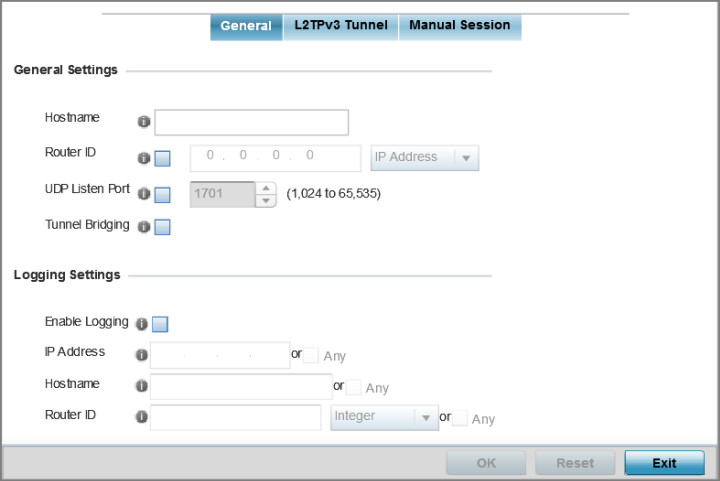L2TP V3 is an IETF standard used for transporting different types of layer 2 frames in an IP network (and profile). L2TP V3 defines control and encapsulation protocols for tunneling layer 2 frames between two IP nodes.
Use L2TP V3 to create tunnels for transporting layer 2 frames. L2TP V3 enables controllers, service platforms and access points to create tunnels for transporting Ethernet frames to and from bridge VLANs and physical ports. L2TP V3 tunnels can be defined between WiNG managed devices and other vendor devices supporting the L2TP V3 protocol.
Multiple pseudowires can be created within an L2TP V3 tunnel. access points support an Ethernet VLAN pseudowire type exclusively.

Note
A pseudowire is an emulation of a layer 2 point-to-point connection over a PSN (packet-switching network) . A pseudowire was developed out of the necessity to encapsulate and tunnel layer 2 protocols across a layer 3 network.
Ethernet VLAN pseudowires transport Ethernet frames to and from a specified VLAN. One or more L2TP V3 tunnels can be defined between tunnel end points. Each tunnel can have one or more L2TP V3 sessions. Each tunnel session corresponds to one pseudowire. An L2TP V3 control connection (a L2TP V3 tunnel) needs to be established between the tunneling entities before creating a session.
For optimal pseudowire operation, both the L2TP V3 session originator and responder need to know the psuedowire type and identifier. These two parameters are communicated during L2TP V3 session establishment. An L2TP V3 session created within an L2TP V3 connection also specifies multiplexing parameters for identifying a pseudowire type and ID.
The working status of a pseudowire is reflected by the state of the L2TP V3 session. If a L2TP V3 session is down, the pseudowire associated with it must be shut down. The L2TP V3 control connection keep-alive mechanism can serve as a monitoring mechanism for the pseudowires associated with a control connection.

Note
If connecting an Ethernet port to another Ethernet port, the pseudowire type must be Ethernet port, if connecting an Ethernet VLAN to another Ethernet VLAN, the pseudowire type must be Ethernet VLAN.
To override the profile's L2TPv3 general configuration:
The Device Overrides screen displays. This screen lists devices within the managed network.
The selected device's configuration menu displays.
The L2TPv3 general configuration screen displays.

|
Host Name |
Define a 64 character maximum hostname to specify the name of the host that‘s sent tunnel messages. Tunnel establishment involves exchanging 3 message types (SCCRQ, SCCRP and SCCN) with the peer. Tunnel IDs and capabilities are exchanged during the tunnel establishment with the host. |
|
Router ID |
Set either the numeric IP address or the integer used as an identifier for tunnel AVP messages. AVP messages assist in the identification of a tunneled peer. |
|
UDP Listen Port |
Select this option to set the port used for listening to incoming traffic. Select a port from 1,024 - 65,535. The default port is 1701. |
|
Tunnel Bridging |
Select this option to enable or disable bridge packets between two tunnel end points. This setting is disabled by default. |
|
Enable Logging |
Select this option to enable the logging of Ethernet frame events to and from bridge VLANs and physical ports on a defined IP address, host or router ID. This setting is disabled by default. |
|
IP Address |
Optionally use a peer tunnel ID address to capture and log L2TPv3 events. |
|
Hostname |
If not using an IP address for event logging, optionally use a peer tunnel hostname to capture and log L2TPv3 events. |
|
Router ID |
If not using an IP address or a hostname for event logging, use a router ID to capture and log L2TPv3 events. |
Click Reset to revert to the last saved configuration.